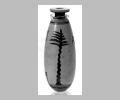
Overview: view of tree

Overview: view of warrior
| Collection: | Krannert Art Museum, University of Illinois |
| Summary: | Negro warrior, tree and table. |
| Ware: | Attic Black Figure, White Ground |
| Painter: | Attributed to the Painter of the Negro Alabastra |
| Date: | ca. 500 BC |
| Dimensions: | h. 15.0 cm; d. of body 15.5 cm. |
| Primary Citation: | |
| Shape: | Alabastron |
| Beazley Number: | 5156 |
| Period: | Archaic |
Condition:
Some repainting where original slip has flaked off; left hand of warrior and center of bow missing.
Decoration Description:
Creamy-white slip, neck black, lip reserved; black band above figure with thin reddish line above and below, reddish line under feet.
A negro warrior stands with outstretched arms, his body frontal, head turned to the left, feet facing right. The head with its characteristic negroid features is disproportionately small for the tall, bulky body; the hair is in the ground color, outlined with black dots to suggest its curly texture. The man wears striped trousers and a long-sleeved upper garment, but the latter is covered by a sleeveless cuirass in which the lines of the pteryges are conspicuous. Below it a flaring, scallop-edged area must represent the chitoniskos which hoplites commonly wear under a cuirass. A scarf loops behind the body, its ends hanging over the arms. The right hand holds an axe, the left a bow. On one side of the warrior is a simple table, on the other a palm tree.
The draftsmanship is not good, with thick and often irregular brush strokes; the figure, ill-proportioned with the peculiarity of feet pointing one way and head looking the other, is awkward. There is little attempt at an integrated design; man, tree, and table are simply spread over the surface. The scene is static.
The Krannert vase and the alabastron owned by Prof. and Mrs. Boulter (gorytos (the combination quiver/bowcase used by the Persians) can be added. The addition of the hoplite cuirass and chitoniskos to the sleeved tunic/trousers combination looks peculiar, but also occurs occasionally on Amazons; where the draftsmanship is better than in the negro group, the details of the armor are clear. The tunic/trousers costume without armor is standard in Greek art for barbarians, real or mythical: Persians, Scythians, Trojans and Amazons. It was actually worn by some peoples of the Achaemenid Persian Empire, and at least East Greeks must have been familiar with the costume even before the Persian Wars. The weapons carried by the black warrior, axe and bow, are typical for Amazons but can be used by other barbarians. The palm tree may be an allusion to the tropical land to which black men are indigenous, but the reason for the table is obscure; occasionally it holds an object but more commonly, as here, it is bare.
The ethnic origin of the warrior is uncertain. The racial type is that of inhabitants of the Sudan, in antiquity usually called Ethiopians. Although Herodotus (
Beazley has identified the "Group of the Negro Alabastra," but the close similarity in subject and drawing technique among the vases suggests they are the work of a single hand; hence we prefer "Painter of the Negro Alabastra." Beazley's derivation from the school of the Syriskos Painter seems untenable in view of the differences in style between his works and those of the "Group of the Negro Alabastra."
Fraser believes the group dates from after the Persian Wars since he is convinced the men depicted are mercenaries in the Persian army but, as stated above, this is not necessarily so since Greeks were familiar with the costume before that time. From the seventh century on, the Greeks had lived in Egypt and knew the negroid physical type. The form of the vessel indicates a date before the appearance of the sharp-shouldered, flatter-rimmed type of alabastron used by the Diosphos Painter in the early fifth century, and a date of around 500 B.C. for the Negro Group is reasonable.
Shape Description:
The slender vessel with narrow neck and flattened rim, originally derived from Egyptian stone vases, is used in Greece as a small container designed to hold perfume, oil, or some other valuable substance.
Essay:
Collection History:
Gift of Harlan E. Moore
Sources Used: